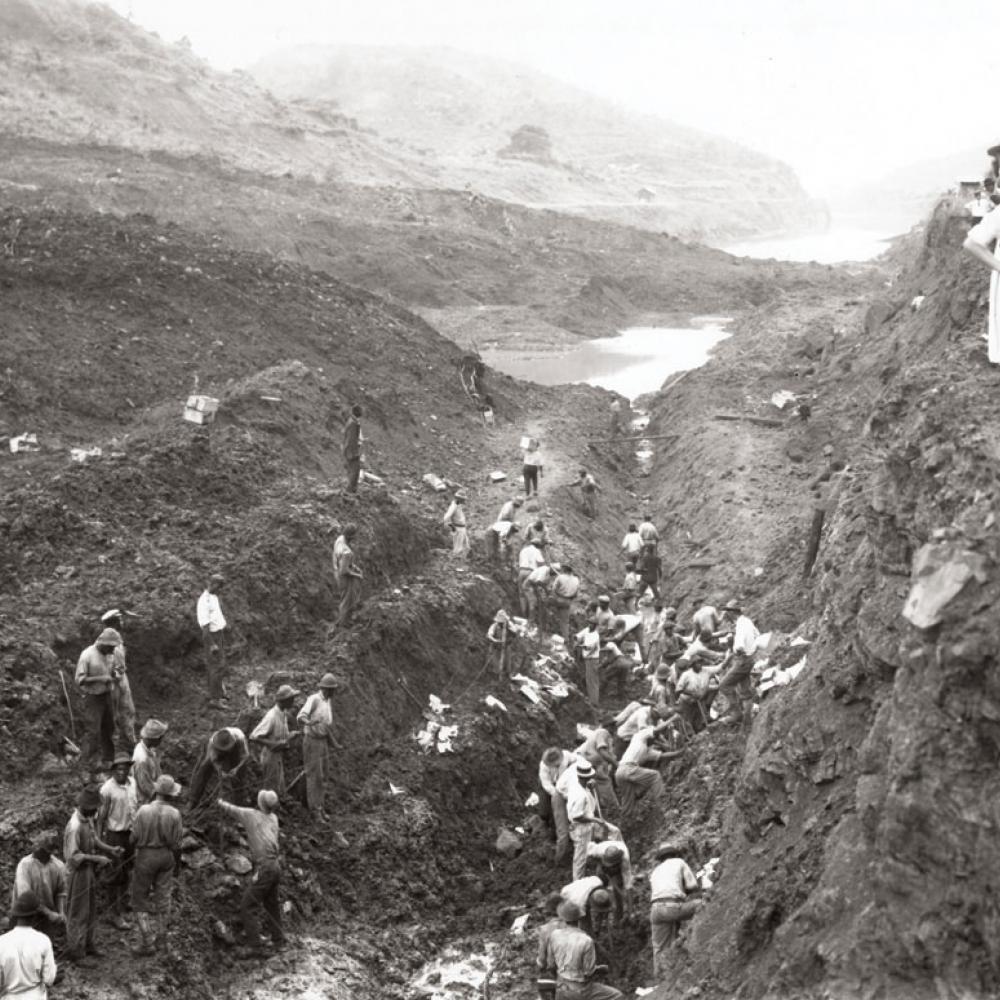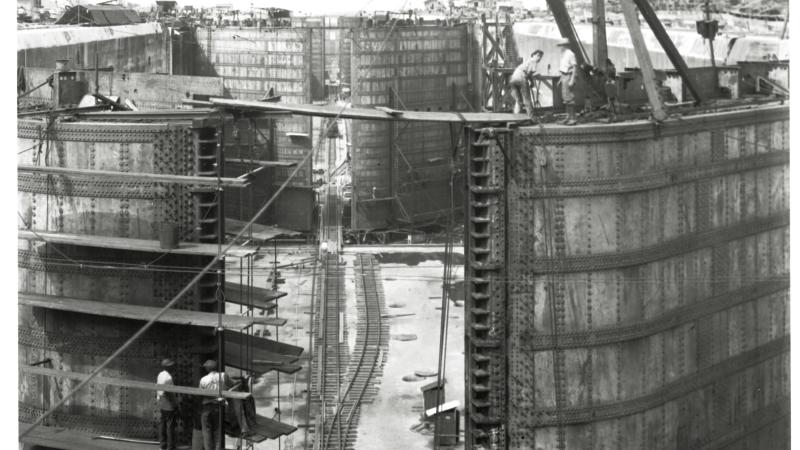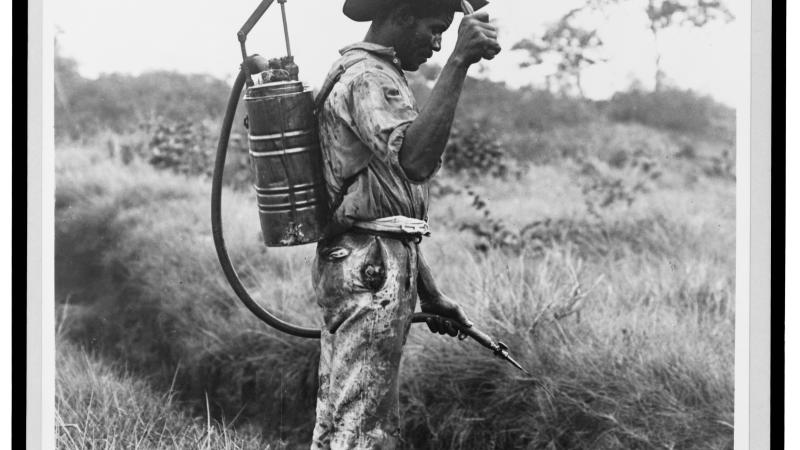The Panama Canal marked a transition: from the great public works of classical Egypt, Rome, and China, built by backbreaking labor, to the far more mechanized triumphs of the twentieth century. And as a monument to optimism and national pride, only the U.S. space program of the 1960s has been its true successor. Both the canal and the moon landing were assertions of American military power and engineering prowess. Both mobilized outstanding international talent to overcome obstacles that could not be gauged fully at the outset. Each was launched by a charismatic new president in the wake of a crisis: by Theodore Roosevelt shortly after assuming office following President William McKinley’s assassination, by John F. Kennedy not long after the Bay of Pigs fiasco. Each project subordinated economic calculation to political and military logic and was a bonanza for suppliers of state-of-the-art equipment. Each pushed the endurance of the human body to its limits, enlisting physicians alongside engineers. They aimed, respectively, at control of the sea and of space, but each also changed global consciousness: one by linking the two great oceans, the other by creating iconic images of an astronaut planting the American flag on the moon and of the earth as a fragile blue island.
Though the program does not mention the Apollo missions, the evidence of the PBS documentary Panama Canal suggests that for all these similarities, there were equally striking differences. In the 1960s, America was the dominant superpower, challenged in space by the Soviets and Sputnik; in the early 1900s, America was just emerging as a global force after defeating Spain. In the canal’s case, though, the impetus was not the threat of a European power’s success but the consequences of what was deemed the century’s most spectacular technological and financial failure, the French sea-level canal project in Panama.
France had been America’s scientific inspiration. Thomas Jefferson eagerly noted its eighteenth-century standardization of military parts, which sparked American mass production after its introduction in our own arsenals. Our first academic engineering program was created at the U.S. Military Academy at West Point by its superintendent, Sylvanus Thayer, a civil engineer who revered French technical education and reformed the curriculum on the model of his other alma mater, the École Polytechnique (still under the French Ministry of Defense today) with compulsory French instruction. Ferdinand de Lesseps, who had become a world hero of civil engineering as well as a national icon as the builder of the Suez Canal, believed he could repeat his success with a sea-level canal across the Isthmus of Panama. He discovered too late the exceptional difficulties of the site: unstable soil, overpowering vegetation, virulent diseases, and especially the turbulent Chagres River. Over eight years, twenty thousand lives were lost to work hazards, malaria, and yellow fever. There was little to show for an investment of more than a billion francs, the equivalent of $280 million today. By the time the project collapsed, the eight hundred thousand shareholders had lost their savings, the greatest crash of the nineteenth century, according to Matthew Parker’s Panama Fever.
While de Lesseps never recovered professionally or psychologically, his chief engineer, Philippe Bunau-Varilla, who had a personal fortune at stake, refused to abandon the project, even after a new Panama Canal company was ready to give up and American politicians and strategic planners were leaning toward a canal through Nicaragua instead. He allied himself with the original superlobbyist and master fixer, the attorney William Nelson Cromwell. Then, as sole representative of the newly independent nation of Panama (freed from Colombia by a revolution protected by American warships), Bunau-Varilla signed a treaty that gave the United States virtual sovereignty in the Zone and a free hand to build the canal.
The Hay–Bunau-Varilla treaty was one-sided, even by the standards of its time. But it reflected a widespread western belief in benevolent imperialism. Theodore Roosevelt wrote to a friend at the British Foreign Office that just as British rule in Egypt and India benefited those countries and the world, so American hegemony would be good for the Panamanians. Woodrow Wilson later declared that his own military interventions would “teach the South American Republics to elect good men.” Among early twentieth-century great powers, and some smaller ones, despite voices of dissent, arrogance was ecumenical.
The open projection of power would not be enough to build a canal where the French had failed. Another attitude was needed: promethean self-confidence. When the treaty was signed, nobody knew how to solve problems that had defeated the French. The majority of the Board of Consulting Engineers, an expert international committee, recommended a sea-level canal like the one de Lesseps had attempted. While the force of the Chagres River would have overwhelmed it and doomed the project, proponents of lock construction realized their own solution also had disastrous precedents, including the failure of the Johnstown, Pennsylvania, dam and a vessel’s collision with a lock on Britain’s Manchester Ship Canal.
Perhaps only a state enterprise backed by military methods could have solved such open-ended problems of building the canal. America’s experience in building transcontinental railroads across inhospitable terrain certainly helped. The first head of canal construction, John Wallace, was a railroad engineer attracted by a salary second only to the president’s on the federal payroll. It was John Stevens, an even more notable railroad builder, whose observations of the realities of the site’s greatest challenge, the Culebra Cut, led him to convince Roosevelt to back the lock idea, a minority viewpoint. But the ultimate direction of the project fell to a career engineering officer, George Goethals. Construction was a paramilitary operation: Although paternalistic, the venture was enlightened by the standards of the day.
How did the United States succeed where perhaps the most admired engineer of the nineteenth century had failed? Timing was part of the answer. France was a world leader in medicine, but it was Walter Reed, a U.S. Army physician, who recently had eradicated yellow fever in occupied Havana by preventing mosquito breeding, applying decades of studies by the brilliant Cuban physician and epidemiologist Dr. Carlos Finlay. Another army doctor, William Gorgas, relentlessly used the same method to suppress mosquitoes in the Canal Zone, eliminating a major source of the French project’s high mortality rate. Bucyrus steam shovels, recently developed, moved earth three times as fast as French equipment. Advances in electrical engineering by the 1890s made possible hydroelectric-powered, motorized lock systems with controls that performed superbly for decades. The mass-circulation newspapers and magazines that began to flourish in the mid-1890s stoked popular enthusiasm.
The project benefited from more troubling changes too, especially from the drop in world sugar prices that put pressure on wages in Barbados, a preferred source of labor. The canal was staffed according to blatant racial and ethnic stereotypes. Chinese laborers, initially favored for their heroic work in railroad building, were considered too ambitious. Once they arrived, they might leave digging for shop keeping. American laborers, white and black, as well as Europeans, were thought too likely to agitate and strike. West Indians were favored for the most arduous and dangerous jobs; the ten cents an hour the canal offered surpassed the dwindling wages of Caribbean plantations. White managers and skilled workers were paid in gold, the West Indian laborers in silver, specie that was also a euphemistic metaphor for the color line.
For many viewers of the American Experience program, one of the great surprises may be the extent of high-handed management by Goethals. Unlike some later “czars,” he actually could rule autocratically, dominating Canal Zone life as well as the actual construction work. He set his tone early by refusing to negotiate with some of the most skilled and apparently indispensable workers, the steam shovel operators, effectively shutting down the project until strikebreakers arrived to replace them. His ruthless drive was most apparent in the nonstop excavation of the canal’s most daunting section, the Culebra Cut, where landslides constantly imperiled all workers on the site, but especially the West Indians, whose living conditions remained miserable. But the men of the “Gold Roll” who did not challenge his authority or the wage scale enjoyed increasingly comfortable accommodations, reversing the initially high turnover and persuading families to join their men. For them, the military strongman created a tropical welfare state that persisted well into the new century.
The Panama Canal illustrates the principle that the economist Albert O. Hirschman has called the Hiding Hand. People begin many enterprises because they don’t realize how difficult they actually are, yet respond with ingenuity that lets them overcome the unexpected, as the Apollo program’s engineers and astronauts were later to do. The testimony in Panama Canal also shows the power of the heroic image of technology in the early twentieth century. It was felt even by the exploited laborers, who still shared the nineteenth century’s stoic approach to industrial risk. Three percent of white American workers and nearly 14 percent of West Indians died. Despite improvements in sanitation, it was “a harsh nightmare,” the grandson of one of those workers declares in the program, but he also recalls the pride of his grandfather in participating in one of the world’s great wonders. In fact, many returnees were inspired by their achievement to join movements for greater economic and political equalitiy in the 1920s and 1930s, the roots of the decolonization movement.
No change to the world’s landscape since the Panama Canal—the Interstate Highway System, the Channel Tunnel, or China’s Three Gorges Dam—has come close to its acclaim. It has kept its magic even as the other great technological breakthrough of its time, aviation, has passed from inspiration to regimented mass routine.
It was conceived without today’s cost-benefit analysis. The historian Walter LaFeber acknowledged in 1978, during often emotional controversies over new U.S.-Panama treaties, that “[w]hether the investment [of $400 million in the Canal] has been amortized is an unanswerable question. . . . like a thousand-piece jigsaw puzzle which has important pieces missing.” Members of Congress, he continued, had really wanted to subsidize shippers and never thought about recovering construction costs.
A sea-level alternative through Nicaragua might well have made more economic sense, but overcoming the landslides, the flooding, the heat, and the mosquitoes that threatened to doom completion, as documented by print mass media at their height, made construction in Panama uniquely audacious. Perhaps our aspirations both on earth and in space are more modest now because we are more rational in our ability to foresee costs, especially environmental ones.
Planners of any future grand ventures should bear in mind the words of Joseph Gavin, in charge of the original lunar module of the space program, applicable to all the canal’s builders from de Lesseps to Goethals: “If a project is truly innovative, you cannot possibly know its exact cost and exact schedule at the beginning. And if you do know the exact cost and the exact schedule, chances are that the technology is obsolete.” Or as global student graffiti was proclaiming in 1969, year of Apollo 11: “Be realistic. Demand the impossible.”
© Edward Tenner




